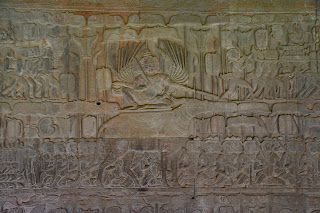Luang Prabang to Angkor – Day 10: Angkor
I set today’s alarm to six o’clock, but I was up much earlier. Siam Reap is a city whose peace has been destroyed by tourism, and the pounding of drums and bass guitars in nightclubs can be heard from afar until sunrise. After packing our bags and eating a quick breakfast, we ordered a Grab to the eastern entrance of Angkor Wat. While this was my second time visiting the temple, I was still surprised by the width of its moats and the length of its walls. We walked around the arcades decorated with bas reliefs of heroic battles and dancing apsaras before ascending to the very top of the temple’s central tower.
Angkor Wat
was built in the 12th century by Suryavarman II as a Hindu temple
dedicated to the god Vishnu. In 1177, the Chams – another Hindu civilisation –
sacked Angkor, and Jayavarman VII established the new capital of Angkor Thom
just north of Angkor Wat. At the very centre of this temple, the king erected
Bayon, which replaced Angkor Wat as the state temple. Unlike Angkor Wat,
however, Bayon was founded as a Buddhist temple to honour the wishes of the
king’s devout Buddhist wife. During this period, Angkor Wat also started
absorbing Buddhist influences and was eventually converted to a Buddhist shrine,
with many of its Hindu sculptures replaced by Buddhist ones. Both Buddhist and
Hindu statues now coexist within the temple, and devotees of both religions can
be seen worshipping their chosen divinities.
We walked
through the Angkor Wat complex from east to west, and rejecting the services of
tuk tuk drivers, we embarked on a fresh morning walk to Angkor Thom. Just like
Angkor Wat, Angkor Thom finds itself protected by a moat, which is crossed by
bridges in all four cardinal directions. We entered by the southern bridge. On both
sides, serving as a railing, large statues of the Hindu gods and demons churn
the Sea of Milk, with a giant naga serving as a rope. They are overlooked by a
gate with four giant smiling faces, which prefigure the faces on the towers of
Bayon Temple. It is unclear whether these faces symbolise Buddha,
Avalokiteshvara, Brahma, or even Shiva, though some believe they were modelled
on the face of Jayavarman VII himself. Bayon Temple is also well known for its
bas relief showing fishermen on boats, with one unfortunate man in the jaws of
a crocodile.
After our
visit to Bayon, we walked around and ascended the nearby Baphuon Temple,
continuing to the Terrace of the Elephants. This terrace is famous not just for
its bas reliefs but also for its fine statues of three headed elephants, which
emerge out of the terrace walls. The next temple on our list was another half
an hour walk away, and with the heat picking up, we decided to hire a tuk-tuk.
Since we had burned through our cash much faster than we had expected, however,
we stood firm when the driver tried to persuade us to have him drive us around
for the day: we figured we might use the rest of our cash for lunch and then
use Grab to get around.
This plan
was put to the test at Prasat Preah Khan, a quieter temple with another set of
gods and demons churning the Sea of Milk across its eastern moat. Having
finished our lunch, we were left with enough cash to pay for several
hours-worth of driving, but now we could not find a driver to take us and
neither of us had cell service. Fortunately, the server at our restaurant had
overheard us talking to an unavailable tuk-tuk driver and arranged for a friend
or younger relation (likely her younger brother) to drive us around for a fee
that we could afford. From Prasat Preah Khan, we rode on to Ta Keo, then Ta
Prohm – famous for its shrines overgrown with towering trees – and finally the
majestic Pre Rup Temple. Hoping to take good pictures in the afternoon light, we
stopped by Angkor Wat for a second time on the way back to Siem Reap, but the
sky had turned dark with clouds, and it began to rain as we entered the
galleries. This bad luck at least had one silver lining: we found the famous
bas relief which depicts the churning of the Sea of Milk.
Once we
returned to the hotel, we only had two preoccupations. Firstly, we needed to
book a Grab cab to the airport and secondly, we needed to get rid of our few
remaining riels. Barron managed to largely solve the latter problem with his
craving for a dragon fruit shake, and once we reached the airport, we found a
donation box to deposit the rest. Despite the heavy rain, our plane left on
time, though we still had enough of a wait at the airport to gorge ourselves on
free lounge food.


















































Comments
Post a Comment